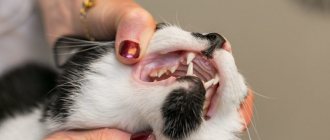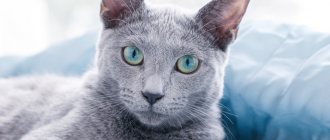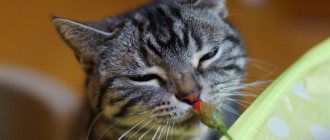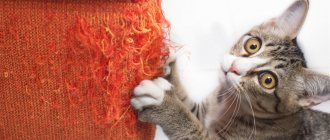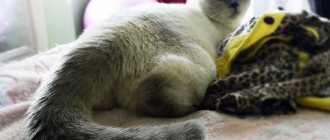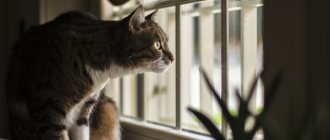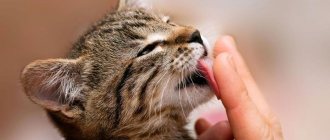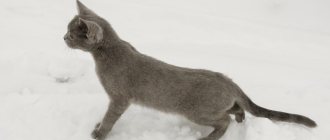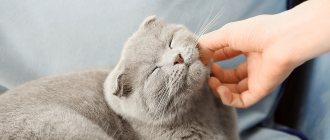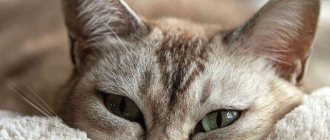Many cat owners have heard their pet make these strange, either chirping or clicking sounds, very reminiscent of grinding teeth.
This happens when a cat sees potential prey outside the window and cannot reach it, which undoubtedly serves as a sign of its disappointment or excitement from a failed hunt. This happens much less often at the sight of food. It also happens in a dream.
But what is much less harmless is if this happens while eating, because it is usually associated with some kind of pathology, and can continue permanently, unless the animal’s teeth are incorrectly positioned.
Why do cats click?
When hunting, cats often make clicking sounds, which apparently serve as a warning to other members of the pack that prey is nearby.
Produced at varying frequencies, these clicks allow the cat to communicate with other members of the pack without alarming the prey. If you don't like the prospect of your garden becoming a bird slaughterhouse, call your cat inside whenever you hear those clicking sounds. How kittens talk. So far we have only talked about the sounds that adult cats make, but kittens also have a voice, and their sounds can be a very pleasant object for study - you will understand how their initially limited vocabulary gradually grows due to the fact that they imitate the sounds of adult animals .
If you have the opportunity, try to record the evolution of a cat's tongue using the method I describe below.
The rumbling begins no later than on the second day after birth, and the greeting “m-r-r-r-n” appears in the third week of life, then other “mur-murs” develop in the following weeks.
Listening to kittens trying to hiss aggressively for the first time, you may be amazed, because the “ugh”, “ugh”, “ugh” they produce sounds more like human speech than a cat’s.
It is difficult to say absolutely exactly when and how a given cat will talk, since each cat represents a distinct personality, just like you and me - some may be talkers, others prefer to keep their mouth shut. You may have a calm, “impenetrable” cat who can hardly force himself to say a couple of “phrases” a day, or a restless chatterbox who talks nonsense all day long.
Cats use their calls in a variety of situations, but here we'll touch on the conditions in which you're most likely to be able to communicate with your animals, as well as explain the sounds that are used.
Looking for reward. These are situations in which your cat craves a specific reward, most likely food or a favorite toy. The importance and meaning placed in any given goal is reflected in the number and intensity of your cat's calls. If you want to understand which of two possible food options she will prefer, show her both of them, one by one, placing them on the floor out of the cat's reach. By comparing the frequency and volume of her calls, you can easily understand what she will prefer.
Demanding your attention. Some cat calls are “reserved” exclusively for conversations with people, and they express a certain need or emotional state.
Greeting purrs are much more often directed towards people than towards other cats, and, as a rule, are used to greet someone the cat knows and likes well. Most likely, you will hear this purring when you return home after a short absence, especially if you are the first to speak to the cat in a friendly tone.
If you suspect that your cat is sick, feels unwell, or is not coping well with changing weather, talk to her sympathetically and show interest in her. If your cat reacts with a plaintive meow, your suspicions are justified.
Confidence. The degree of confidence with which your cat performs a particular task is also reflected in its calls. If experience has taught the cat that performing this task should be accompanied by a confident cry, then she places emphasis on the first “a-a-a” sounds of her call.
How cats talk to each other. Most animal owners are aware of their calls towards each other only during the mating season. A cat communicates its mood loudly, and its cry cannot be confused with any other, while cats fighting for their territories stage a typical “cat concert.” The sexual invitation is accompanied by a coaxing purr.
During pregnancy, the cat conveys its demand for additional food, water, and also sympathy, emitting often, often pleading calls. When talking to kittens, she uses soft purring sounds and licks them in accordance with a precisely determined genetic sequence.
She pays the greatest attention to the lumbar and groin areas of her kittens; she licks them thoroughly, then licks the bellies of her pets, then the sides and back. (Licking is also important for cats' recovery.)
When the kittens are old enough to leave the nest, the cat continues to use the same variety of purring to attract their attention, but the harshness and intensity of this purring increases. When she invites the kittens to play, she uses a soft, persuasive call. However, if they do not respond to it, the calls become more dissatisfied and complaining. If their play gets too boisterous, the cat may use an angry call mixed with indignation. However, in my practice, such signs of irritation rarely made an impression on naughty kittens.
Source
Tail signs
The tail is the most powerful indicator of a pet's condition. It can be considered a kind of mood indicator. What can he talk about?
If the cat is irritated or interested in something, it will wave the tip of its tail from side to side. Such twitching indicates a slight degree of irritation, which can develop into an aggressive manifestation of dissatisfaction.
When a cat flicks its tail sharply up and down, it is showing strong excitement and anxiety. His hair stands on end and he becomes fluffy. She gets very angry and is ready to attack. In this state, it is better to leave the animal alone.
Depression and a state of fear are characterized by a tail clamped between the legs. In order for the cat to calm down, it is necessary to eliminate the source of danger.
A raised tail with a straightened or slightly curved tip expresses the joyful state of a pet. Conversely, a drooping tail shows the animal is tired or disappointed.
If the tail trembles, it means the animal is marking its territory.
Another simpler pattern of tail signs in cats.
Why does a cat constantly lick itself: reasons for unusual behavior
Whiskered pets are the cleanest pets. They wash themselves not only after eating, but every time after being touched by a person. Despite this, cleaning a fur coat is not always associated with actual contamination. If a cat constantly licks itself, then the cause of this behavior may be pathology. In this case, you should contact your veterinarian.
Grinding of teeth, nausea or vomiting in a cat
Sometimes the grinding is accompanied by other unpleasant symptoms. If a cat is sick or vomiting, then these symptoms may indicate the presence of parasites in the pet’s body, diarrhea or constipation develops, appetite worsens, and body weight decreases.
A cat burps and grinds its teeth if it suffers from uremic gastritis or liver diseases.
The animal eats poorly and often makes chewing movements.
Additional symptoms include:
- general weakness;
- urinary disturbance;
- bad breath.
The animal vomits when kidney problems develop. Such pathologies are accompanied by frequent urination, nausea, lethargy and apathy.
Natural causes
Natural causes include everything that happens on an instinctive level. Reflex licking is harmless and does not require outside intervention.
Hunger or thirst
Intense production of saliva is caused by a delicious smell, as well as the sight of the food itself, if the cat has not eaten for a long time. This reflex facilitates subsequent chewing and swallowing of food.
Don't forget about thirst. The desire to drink increases in hot weather and when eating dry kibble. If there is no constant access to water, then due to thirst the pet will often swallow and lick itself.
Washing after eating or drinking
A cat licking its lips should not surprise its owner immediately after eating or drinking. In this way, it removes food debris and its smell, and also licks off excess water.
Maintaining normal spout moisture
In the absence of pathologies, the nose of mustachioed pets is wet and cold. The appearance of dryness and warmth, eliminating illness, is acceptable during sleep and in hot weather. In both situations, cats lick vigorously, trying to regain lost phlegm.
Fur stuck on tongue
After washing, rare fragments of fur get stuck on the rough tongue. They cause discomfort to the animal, so to remove them the body stimulates the production of saliva. Because of this, the cat has to lick itself more often than usual.
Causes of pathology when eating food
If a cat grinds while eating, the causes may be various diseases of the gums and teeth:
- Tartar. It is characterized by dense growths of a yellow-brown hue on the periodontal groove.
- Periodontal disease. This is an inflammatory process accompanied by degeneration of gum tissue. As a result, when the animal eats food, its teeth become loose. Their friction sounds like a squeak. This symptom occurs in the last stage of the disease.
- Gingivitis. With this disease, the gums become inflamed. Signs of the pathological condition are redness and swelling of the gums, and the appearance of pustules in the oral cavity.
- Other dental pathologies. Various dental defects and their improper development can also lead to a cat starting to chatter its teeth.
The sign also indicates a subluxation or dislocation of the pet's jaw . A cat can get injured after an unfortunate fall. In older animals, a common cause of jaw subluxation is a strong yawn.
If your kitten grinds his teeth, the cause may be tooth loss. Usually this phenomenon is observed between the ages of 4 months and six months.
The symptom develops in certain kidney and liver diseases. When these organs malfunction, uric acid salts and bile enter the oral cavity through the bloodstream.
These substances begin to irritate the mucous membranes, cause itching of the gums, and the tooth surface is destroyed. The animal begins to clang its teeth.
Rabies in a cat can also manifest itself as squeaking. This is explained by the fact that when chewing, the pet experiences severe pain.
Why a cat constantly licks itself: pathological reasons
Dangerous causes are accompanied by accompanying symptoms and an increase in the number of daily washings. Hygiene procedures occupy most of the waking hours, and the general condition of the mustachioed pet gradually worsens.
Nausea and conditions preceding vomiting
If your cat frequently licks and swallows, the reason for her strange behavior is most likely due to impending vomiting. Before an attack, animals wash only their faces, ignoring other parts of the body.
Nausea itself is not an independent disease. It accompanies gastrointestinal diseases, helminthiasis, poisoning and other dangerous pathologies that require the intervention of a veterinarian.
Nervous disorders
Mental problems should not be ruled out. These include stress and phobias. The former are associated with increased nervous tension, and the latter with severe fear that defies logical explanation.
Washing removes unpleasant odors, so whiskered pets feel calmer after washing. Rubbing against surrounding objects also helps them. In this way they distribute their pheromones secreted by their facial glands.
Diseases of various body systems
Another possible diagnosis option is systemic diseases. These include:
Diseases of the urinary system (renal failure, ICD). The cat urinates frequently and drinks a lot. Severe nausea due to intoxication and weight loss are noted.
Gastrointestinal pathologies (gastritis, pancreatitis, dysbacteriosis). Accompanied by stool disturbances, vomiting and loss of appetite.
Diabetes. Lack of glucose leads to excessive and frequent urination, increased thirst and appetite, as well as rapid weight loss.
Tumors in the oral cavity. Causes intense salivation and pain. Due to unpleasant sensations, the pet refuses food, but constantly approaches the feeder, feeling very hungry.
At the initial stage, most of these diseases are asymptomatic. A clear clinical picture appears only after complications, so until this point only a veterinarian can make a diagnosis.
Foreign body entry
Another reason why a cat constantly licks and swallows is the entry of a foreign body into the oral cavity or its ingestion. In the first case, the body tries to remove the foreign object on its own - through excessive salivation and vomiting. In the second case, these methods do not work, so the swallowed object is removed surgically.
Poisoning or infection
An attack of vomiting, accompanied by frequent licking, diarrhea and high fever are characteristic of intoxication of the body. It is caused by poisons, chemicals, spoiled foods and infections.
Problems with teeth or gums
Problems with the oral cavity should not be ruled out. Constant licking due to excess saliva occurs with caries, pulpitis and periodontitis. All these diseases can be accompanied by a putrid odor from the mouth, increased swallowing and loss of appetite.
Helminth infection
The risk group includes cats that walk outside and eat raw meat or fish. Parasites can be recognized by severe itching, weight loss, diarrhea, deterioration in coat quality and bloating.
With helminthiasis, a cat licks wounds on the body that form due to scratching. Because of this, they can easily get a secondary infection, so at the first signs of infection, you need to make an appointment at the veterinary clinic.
Skin problems causing itching
Scabies appears not only due to worms, but also due to other skin problems. These include:
Allergy. The symptoms of the disease depend on its cause. The cat may experience skin rashes, diarrhea, vomiting, runny nose and local baldness.
Dermatitis. The main symptom of dermatitis is the presence of inflammation on the skin. It peels and turns red, or becomes wet and ulcerated.
Flea infestation. Flea bites are not only painful, but also dangerous. These parasites carry deadly infections, and their saliva often causes allergies.
Please note that cat fleas do not disdain human blood at all. Unlike their brothers, they easily adapt to new owners. Thanks to this, flea infestation is very easy to distinguish from other diseases that cause itching.
Sight
The visual organ reflects well the mood of the cat. If the pet is in a calm mood and does not feel danger, then its eyes will be closed or half-closed. This is how he expresses his trust.
A cat shows curiosity through wide open eyes. So she studies the world around her with interest. But there is another meaning. An open gaze can indicate fear or aggression. In this way she tries to scare the enemy. Most often, this look can be found in fighting cats.
Cats do not like direct and long eye contact. They perceive this behavior as a challenge.
Helping your pet at home
Before contacting the veterinarian, be sure to note the accompanying symptoms and remember all recent events. You can solve the problem by eliminating the root cause:
Nervous disorders. Attention (affection, playing with a rope) and sedatives with pheromones will help cope with stress. If it's all about fear, change the conditions of detention. Most often, mustachioed pets suffer from claustrophobia, so they need more personal space.
Entry of a foreign body into the oral cavity. If the object is not deep, remove it with tweezers.
Poisoning. At home, it is permissible to provide first aid aimed at slowing down the intoxication process. This includes gastric lavage, taking sorbents, giving an enema and rinsing the skin from toxic drugs.
Flea infestations and helminthiases. Most antiparasitic drugs can be taken without prescription. Exceptions include young age, pregnancy and severe disease.
Allergy. If you know the allergen, then try to get rid of it: change food, shampoo and other possible irritants. If there are no changes, use antihistamines.
In all other cases, treatment is selected by the veterinarian. Depending on the condition, the pet may require not only conservative, but also surgical therapy.
How to help your pet
To help your cat, you must first determine why this symptom develops. Medications in the form of tablets, drops, injections, and surgical methods can be used. In some cases, the animal is prescribed a special diet.
What to do in case of teeth grinding depends on the cause of the development of this condition:
- If your cat has a subluxated or dislocated jaw, it needs to be realigned.
- In case of nervous shock and stress, the animal is prescribed sedatives.
- To treat periodontal disease and stone, medications are used for hygienic cleaning of the oral cavity (Chlorhexidine, Miramistin, Furacilin, Metrogyl and hydrogen peroxide). In advanced forms of the disease, it is possible to remove teeth under general anesthesia.
- When a cat has parasites, anthelmintic drugs are prescribed. Products are used for internal or external use.
- If a grinding sound occurs due to food, it is necessary to adjust the animal’s nutrition. It is advisable to alternate soft and hard food.
- To facilitate the change of teeth in kittens, you can massage the gums.
If a cat has liver or kidney disease, experts recommend giving your pet food low in protein and plenty of fluids.
If teeth grinding is caused by rabies, the animal will die. He urgently needs to be isolated . The pet owner is prescribed a course of vaccination. Unfortunately, this disease is incurable for animals. You can avoid it by vaccinating your cat.
What symptoms require an urgent trip to the vet?
If you feel stable, you can wait a little longer with the diagnosis. Urgent veterinary care is only necessary when the following symptoms appear:
loss of motor activity and response to external stimuli;
increase or decrease in body temperature;
partial or complete loss of appetite, as well as sudden weight loss;
deterioration in coat quality (dullness, thinning, baldness);
the formation of ulcers, rashes, papules and blisters with liquid on the skin;
severe itching accompanied by active scratching;
increased thirst or refusal of water;
frequent vomiting and diarrhea.
With such symptoms, self-help will not only not bring results, but will also cause harm. Instead, the sick pet should be taken to the veterinarian. The reason explaining why the cat often licks itself will be determined after passing all the necessary tests. Based on this, treatment will be selected for the patient.
Cat concert under the windows
Usually something like this happens in the pre-dawn hours and just when you really want to sleep! These wild screams are difficult to confuse with any others: the surrounding cats are sorting things out among themselves. The subsequent fight will reveal the winner, who will gain access to the beautiful lady waiting for her gentleman. Don't want to see your pet on the list of soloists? Castrate or sterilize him - and you will have peace and quiet.
Today we will talk about such a phenomenon as cat screams and “crying” or, scientifically speaking, the vocalization of cats.
Spring is just around the corner, which means that in a large number of houses and apartments, feline sexual instincts will awaken, and the owner’s sleep will become restless. And it’s not just that the loud voices of anxious cats and kittens interfere with the rest of their owners and their neighbors. It would be nice if only this...
The fact is that the owners of mustachioed cats reverently experience the cat’s suffering almost as if it were their own. “Almost” - because sometimes the suffering of cats bothers their owners even more than their own.
Of course, the cat cries so much, screams so much, bends over and suffers so much! She's in pain, she's complaining so much! How could we help her, what could we give her right now so that she would shut up and we would stop worrying about her?!
Probably, in order to solve the issue of stopping cat screams and crying, it is worth understanding in more detail the nature and manifestations of cat vocalization.
Let's look at the reasons why cats vocalize. Do cats suffer as much during the manifestation of sexual instincts as their owners think? What other phenomena are hidden behind cat cries? Can cats “cry” not only from heat? How does a cat react to pain and does it “cry” when it really hurts?
Why does a cat need a loud voice?
If you look closely at the behavior of cats in a group, you will notice that cats use a loud voice only in exceptional cases. Each cat's vocal signal has a very specific specificity and is quite easily recognized by relatives and other attentive listeners.
What does a cat say in a loud voice?
- First of all, that she is ready to reproduce.
- About the approach of a stranger to the borders of his territory.
- That she is very dissatisfied with something.
- About demanding something from the owner.
- A sharp, sudden pain in the abdominal cavity, usually of a spastic nature.
- About the headache.
- About other causes of discomfort...
Let's take a closer look at some cat signals.
Cries of March cats
Sexual behavior of cats is accompanied by loud screams and “crying”, in a word, vocalization. This applies to both females and males. The female cat screams to announce that she is in heat, and the male cat announces that he is here, nearby.
As a rule, the cries of cats during the display of heat (readiness to mate) are very loud, “guttural”, not similar to others, except, perhaps, for some territorial warnings. Typically, sexual vocalization becomes most powerful when the cat is not exposed to other stimuli. This means that cats and kittens, excited by their own hormones and other people’s pheromones, scream loudest when other sounds fade away. Of course, these are night hours or other hours of rest for the owners and their neighbors.
Any strong sound or other irritant, such as a bucket of water from the window at the “grooms” gathered from all over the area, or a slipper flying into the vociferous “bride,” knocks down the “romantic mood” of the tailed ones, however, as soon as silence reigns, the “concert” resumes with new strength.
“Concerts” with several “vocalists” are especially striking. But even one cat in heat is quite capable of ruining the night life of the residents of several neighboring apartments.
Do animals that “scream” suffer because of sexual instincts? Yes, sure. But not from pain as such, but from those desires that overwhelm them, but are not realized. From overexcitation of the nervous system, when “you want something, but I don’t know who.”
The cat calms down after mating, at the end of estrus or after castration, which is often called sterilization. Remember that ineffective estrus that does not lead to pregnancy can lead to the development of polycystic ovary syndrome in the cat, purulent inflammation of the uterus and even breast cancer.
Cats, as a rule, “yell” if they smell the pheromones of a cat in heat or a rival cat. And if both are nearby, then the owners of such a cat can only dream of a good night.
Castration of a cat solves the problem of sexual vocalization. Chemical castration is temporary, surgical castration is once and for all.
Territory protection
Vocalization when protecting a territory is typical for cats, as they say, “free-range.” Cats give warning signals when an “intruder” comes close to the boundary guarded by the cat or violates it. As a rule, the cry of the cat who owns the territory is loud, short, and guttural. If the offender does not run away, then what follows is an attack and a fight “to the bitter end.”
You can distinguish sexual vocalization from territorial vocalization by the duration of the signals and changes in timbre. Territorial vocalizations are characterized by a higher end of the signal and a much shorter duration.
The same territorial signals can be given, especially “in the season,” by residents of city apartments, whose neighbors let their cats “walk” in the common corridor. In this case, sensing a stranger and being excited by the pheromones in the air, apartment cats can stage a “concert” and even write under the door of their own apartment so that the stranger on the other side of the door knows that the territory has an owner.
Discontent, threat, fear
If you accidentally step on a cat's tail or paw, you will definitely hear its displeased cry. This signal is very sharp, loud, ultra-short, designed to scare everyone who attempts to kill the cat. You will hear the same cry if the cat has already entered into a fight. Sometimes a cat makes the same cry during a game in the heat of intense excitement and aggression, usually towards its fellow tribesmen.
With this cry the cat tries to scare. It is important to remember that a cat is scary both when it simply wants to scare the one who is trying to kill it, and when it itself is very scared. This is one of the signs of cat aggression. The scarier the cat is, the more it will try to scare the enemy.
The extent to which the cat perceives the situation as dangerous for it can be judged by the strength and timbre of the cry. The louder and shriller a cat screams, the more dangerous it perceives the situation to be. But the nature of the cry must be compared with the nature of the cry of this particular cat in other conditions. Then the signal will be more clear to you.
Demanding cry
A cat makes such a cry specifically in relation to a person. This is an assertive, demanding cry, most often without shrillness. Sometimes he seems grumpy, clearly expressing feline dissatisfaction with the situation. Each next round of demanding screaming may be louder and/or longer than the previous one. As a rule, the tailed dictator tries to look you in the eye or even tries to bite the “stupid” owners on the legs. In some cases, a demanding cry is replaced or masked by a plaintive one, but the demanding notes always remain in it.
It is important to understand that the pet’s demand is aimed at obtaining a certain result - feed the dictator, play with him, go to another room, remove the odorous contents of the toilet, and the like. If you are sure that you understood your pet correctly, then decide for yourself whether to obey the beast’s demands or not.
Know that if, in a situation where everything is clear and the object of the demands is defined, the owner at least once succumbed to the demanding cry of the pet, then the tailed dictator will continue to use his demanding cry as a weapon of influence constantly. Until you get tired of obeying.
True, there are exceptions. If your pet’s demanding cry occurs in an atypical situation, you should definitely find out its cause. In a number of cases, it was with such a demanding cry that animals warned their owners about the danger that threatened them (fire, earthquake, stranger in the house, etc.)
Screams of spasmodic pain
When you look closely at the animal, these screams cannot be confused with anything. They accompany certain types of cat behavior:
- unsuccessful or ineffective attempts to urinate or defecate,
- gagging,
- changes in posture due to spasms of the intestines or gall bladder (adopting the so-called “prayer pose”).
These cries are similar to expressions of discontent. But there are also significant differences. The most important difference between these screams is that for the cat there is no external “addressee” of the screams; they seem to be directed into emptiness or “inward.” At the moment of such screams, the cat’s attention is directed not at an external enemy or an external source of danger, but inside itself. The animal does not seem to understand where the threat is coming from, but at the same time it reacts to the threat.
As soon as the spasm passes, the screams also pass. The animal calms down until the next spasm and the next attack of characteristic behavior, accompanied by cries of spastic pain.
Some of the animals scream loudly and plaintively, others very quietly. It is important to note precisely the “typical” nature of the combination of screams and behavior of the animal. And, if this is a repeated cry, then a trip to the doctor should be scheduled in the near future. If the frequency and/or intensity of screams increases, and the pet’s condition worsens, this is a reason to urgently consult a doctor.
It is very rare, but it happens that similar screams “standardly” accompany the process of urination or defecation (stool) in a healthy animal. In order not to pay attention to such behavior and not harm your pet, you need to consult a doctor and make sure that your pet really does not experience health problems, and “sings songs” simply out of habit.
Oh, my head hurts...
It also happens that cats suffer from increased cranial pressure.
This happens most often in cats with chronic kidney disease (CKD), which was previously also called chronic renal failure (CRF).
Less commonly, headaches can be caused by brain tumors, impaired outflow of cerebrospinal fluid from the ventricles of the brain into the spinal canal, injuries to the brain and cervical spine, and some other neurological problems. In addition, rapid intravenous infusion of drugs (colloquially “drip”) can cause an increase in cranial pressure.
When a cat has a headache, it starts screaming. At the same time, the owners often look at the cat’s gaze or gaze directed “inward.” The animal usually holds its head at the level of the withers or below. The screams are monotonous, quite loud and strong, and may be accompanied by panicky movements, often meaningless. The duration of each cry can be long or short, but the important thing is that it is the same. The animal practically does not react to the voice and caresses of its owners and behaves like a robot. Some calm down in the arms of their owners, but not for long. The screams soon resume with renewed vigor and standard monotony.
If your animal exhibits this behavior, take your animal to the doctor immediately. As a rule, the doctor analyzes the patient’s neurological status, checks his pulse,, if possible, measures his blood pressure and recommends measures to improve the condition of such a severe patient.
In the case where the pet’s behavior has changed to restless precisely during the “drip” process, the rate of intravenous infusion must be urgently reduced. If necessary, medications that lower blood pressure are used. If the animal’s condition becomes similar after several intravenous infusions, then this is a reason to adjust the treatment. Be sure to discuss your pet's new symptoms with your doctor.
Remember, with such phenomena, diagnosing the causes of headaches is very important. As a rule, in this case, blood tests are required, and ultrasound and even MRI are often required. It is impossible to treat without a diagnosis.
Very similar behavior can be observed in older animals. Such cats and cats, at the age of fifteen years and older, change their behavior and begin to vocalize at approximately 3-4 o'clock in the morning. During the day, such patients often behave quite calmly and sleep more often.
I would recommend that the owners of such animals examine them for CKD, which can sometimes occur in a latent form for quite a long time and manifest itself only in such “night cries.” Well, if there are no kidney or other health problems, then you can try playing with the old people during the day and in the evenings, so that they can rest at night and not sing songs.
Drooling as an additional symptom
Saliva not only facilitates the digestion of food, but also protects the oral cavity. The process of its formation is called salivation, and too intense production is called hypersalivation.
Excessive work of the salivary glands is accompanied by the following symptoms:
frequent washing and swallowing;
regular wetting of the hair on the neck and chin;
the appearance of wet spots in places where the animal sleeps;
rubbing the muzzle on sharp corners;
direct leakage of saliva from the mouth with the formation of icicles on the chest.
Despite regular grooming procedures, the animal’s fur becomes unkempt and disheveled. It is impossible to make a diagnosis based on hypersalivation alone, since it is only a symptom and not an independent disease.
Most often, washing is just a reflex. A cat licking its lips should not be a cause for concern unless there are other symptoms, but in the opposite situation, rational and quick action should be taken. In some pathologies, visiting a veterinarian too late can result in serious complications that are incompatible with life.
The article is for informational purposes only. Contact your veterinarian!
Source
Paw movements
Trampling or fingering its paws means that the pet is happy and satisfied. If the cat is alert, it will freeze with its front paw raised.
When an animal lacks attention or affection, it will touch the owner with its paw.
Squatting on the front legs means an aggressive attitude and readiness to attack. Squatting on its hind legs may indicate confusion in your pet.
Teeth grinding while eating
Most often, a cat grinds his teeth when he eats. At the same time, he may show concern: meow. rub its face with its paws, spit out food.
© shutterstock
The cat creaks while eating (cat grinding his teeth) for the following reasons:
The chewing function includes several stages:
The degree of compression, the nature of the movement of the lower jaw, and the condition of the periodontal disease in their pathology cause the teeth to creak.
Subluxation of the lower jaw
When the jaw is subluxated, the cat clicks its teeth when eating or drinking. Reason: the age of the animal or an unsuccessful landing after a jump. Cats can fall and suffer severe head injuries. One of the consequences of the blow may be subluxation of the lower jaw, which leads to loose closure of the dentition. In older cats, subluxation may occur due to a strong yawn. Weakened ligaments and jaw muscles are unable to hold the jaw in the same position. Teeth grind when trying to close jaws.
© shutterstock
A dislocated lower jaw must be corrected by a specialist. Owners of older cats have to learn this method due to frequent recurrences of subluxations. The reduction scheme consists of several manipulations:
The procedure is painful; the pet needs to have the submandibular nerves numbed.
Infection with worms
Infection with worms leads to intestinal bloating and pain, which the animal tries to drown out by intense chewing. Severe pain of any etiology causes a strong reflex clenching of the jaws, from which the teeth begin to grind. Subsequently, constipation, diarrhea, vomiting appear, and appetite decreases. The animal loses weight, its coat loses its shine, and its immunity decreases. Treatment for helminths involves destroying the parasites. Medicines are available in oral form or externally (drops for application to the skin).
Drugs should be given to the animal for prevention in any case. Cats that are not allowed outside can become infected with worm eggs brought from the street on clothes and shoes. Without following sanitary rules, the fight against helminths will be ineffective. It is necessary to wash and disinfect food and water bowls and trays. Contact with stray animals is a source of infection.
Dental pathologies
With periodontal disease, the periodontal tissues are inflamed, the neck of the tooth is exposed, and the attachment of the tooth in the gum is weakened. When eating, teeth become loose and their location changes. The surfaces of the teeth rub against each other and creak. If several teeth are severely affected by periodontal disease, they are removed under general anesthesia. To diagnose the disease, X-ray and visual examinations are performed. Teeth grind in the final stages of pathology, when bone tissue begins to deteriorate. Clenching of the jaws leads to uneven load, resulting in the cat creaking loudly while chewing.
© shutterstock
Tartar at the junction of the gum and the base of the tooth can interfere with chewing, which is accompanied by a characteristic sound when teeth grind. The animal tries to chew on the side where there is no tartar. It is impossible to remove tartar at home: this requires an ultrasonic unit.
Diseases of internal organs
A cat grinds its teeth if the liver and kidneys cannot cope with their function. Bile acids and urates (uric acid salts) enter the oral cavity through the bloodstream. Bile breakdown products cause irritation of soft tissues. They become inflamed and begin to itch. The cat tries to fight the itching of the gums by squeezing them, causing the teeth to grind. An additional symptom of liver disease is vomiting while eating. Urea salts destroy tooth enamel. It loses its smoothness and becomes lumpy. The deformed surfaces of the teeth creak while eating.
The process of tooth decay occurs in a similar way with uremic gastritis. Its cause is chronic renal failure. The mucous membrane of the stomach becomes inflamed, resulting in increased production of hydrochloric acid. The valve between the stomach and esophagus is disrupted. Reflux occurs (reverse movement), as a result of which stomach contents enter the oral cavity, destroying the enamel.
Treatment of uremic gastritis should be aimed at renal therapy. To relieve symptoms, a low-protein diet with sufficient boiled water is recommended for the cat. Drug treatment is prescribed by a veterinarian after examining the cat’s kidneys and stomach.
Additional signs of uremic gastritis at the initial stage are:
An accurate diagnosis can be made after a biochemical blood test, ultrasound of the kidneys and stomach.
Rabies
Grinding of your cat's teeth while eating may be one of the symptoms of rabies. The chewing process becomes painful. The animal eats slowly due to difficulty moving the lower jaw. Empty chewing movements cause grinding of rubbing dental surfaces (teeth grinding). There is no cure for rabies. The only way to avoid the disease is regular vaccination. If rabies is suspected, when teeth grinding is accompanied by increasing aggressiveness or apathy, the animal is isolated for 2-3 weeks for observation.
© shutterstock
If the diagnosis is confirmed, the cat dies within one to two weeks. For a kitten, this period is reduced to 3-5 days. It is necessary to do an examination of the animal's cerebrospinal fluid. The owner will have to receive 7 anti-rabies injections within 6 months. Otherwise, he faces an incurable dangerous disease.
How is the treatment carried out?
Surgical intervention
Timely vaccination and deworming can protect your pet from dangerous diseases that cause jaw clicking.
Surgery is necessary for purulent-inflammatory process of the jaw. The cavity is opened, pus is removed, drainage is performed, and the wound is cleaned. For osteomyelitis, a sequestrotomy is performed to remove dead areas of bone, periosteum and bone marrow. In case of displaced or open fractures of the jaw, the broken fragments are fastened with metal synthesis instruments.
Drug therapy
The treatment regimen is determined by the doctor based on the etiology of the disease. Rabies is incurable because it is quickly fatal. For tetanus, antitetanus serum is administered, and anticonvulsants are recommended. Purulent-inflammatory processes are treated with antibiotics, which are prescribed by a veterinarian after identifying the pathogen. For helminthic infestations, anthelmintic drugs are effective, and vitamin-mineral complexes are effective to strengthen the body. It is also recommended to cure concomitant kidney diseases.
Other causes of teeth grinding
Replacing baby teeth doesn't always go smoothly. In cases where the owner notices that the kitten’s teeth have begun to grind, it is necessary to look into its mouth. Permanent teeth can grow next to baby teeth. Loose baby teeth cause teeth to grind. A month after the teeth change begins, the grinding disappears. An exception is preserving the baby tooth(s) when the kitten is six months old. This tooth is removed in a veterinary clinic.
The cause of teeth grinding can be neurological disorders after anesthesia . Exceeding the dose of anesthetic, a delay in removing it from the body, features of the nervous system - all this can affect the cat’s condition. In such cases, the cat’s teeth grind, regardless of time and food intake.
When a cat’s teeth grind in a dream, it means that the animal has suffered a nervous shock. The stress experienced has a delayed reaction in the form of jaw clenching in sleep.
Source
How it manifests itself
The symptom manifests itself in a cat as teeth rubbing with the characteristic sounds of grinding or squeaking.
This phenomenon often occurs:
- when eating food;
- after meal;
- during sleep.
Sometimes a cat grinds its teeth as if eating. She makes chewing movements, but there is no food in her mouth.
Teeth grinding is often associated with various diseases, and therefore may be accompanied by other symptoms depending on the pathology. Additional signs include vomiting and nausea, weakness, sleep disturbance, and loss of appetite.
In any case, this symptom cannot be ignored, because it may indicate a serious illness in the animal.
